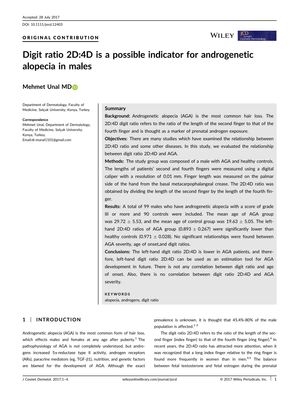TLDR Finger length ratio may indicate male hair loss.
The study investigated the relationship between digit ratio 2D:4D and androgenetic alopecia (AGA) in males. The left-hand digit ratio 2D:4D was found to be lower in AGA patients, indicating that it can be used as an estimation tool for AGA development in the future. However, there was no correlation between digit ratio and age of onset or AGA severity. The study suggests that prenatal androgen exposure may be linked to AGA development. Further studies with larger sample sizes are needed to confirm these findings.
 3 citations
,
June 2016 in “Dermatology Reports”
3 citations
,
June 2016 in “Dermatology Reports” Finger length ratios don't predict baldness in men.
 8 citations
,
April 2016 in “Anais Brasileiros De Dermatologia”
8 citations
,
April 2016 in “Anais Brasileiros De Dermatologia” Right hand finger ratio may predict male hair loss.
 3 citations
,
March 2014 in “Turkderm”
3 citations
,
March 2014 in “Turkderm” Hair loss in men can be slowed or reversed with treatments like minoxidil and finasteride, but it resumes if treatment stops. It may also indicate early heart disease and obesity.
 8 citations
,
April 2016 in “Anais Brasileiros De Dermatologia”
8 citations
,
April 2016 in “Anais Brasileiros De Dermatologia” Right hand finger ratio may predict male hair loss.
 5 citations
,
May 2019 in “Anais Brasileiros de Dermatologia”
5 citations
,
May 2019 in “Anais Brasileiros de Dermatologia” Finger length ratios might predict risk for skin condition in males.
 3 citations
,
June 2016 in “Dermatology Reports”
3 citations
,
June 2016 in “Dermatology Reports” Finger length ratios don't predict baldness in men.
 March 2025 in “International Journal of Trichology”
March 2025 in “International Journal of Trichology” Dermatologists should address discrimination and consider ethnic and gender differences in treatments.
 October 2023 in “Dermatology practical & conceptual”
October 2023 in “Dermatology practical & conceptual” Finger length ratios might help predict common hair loss.







